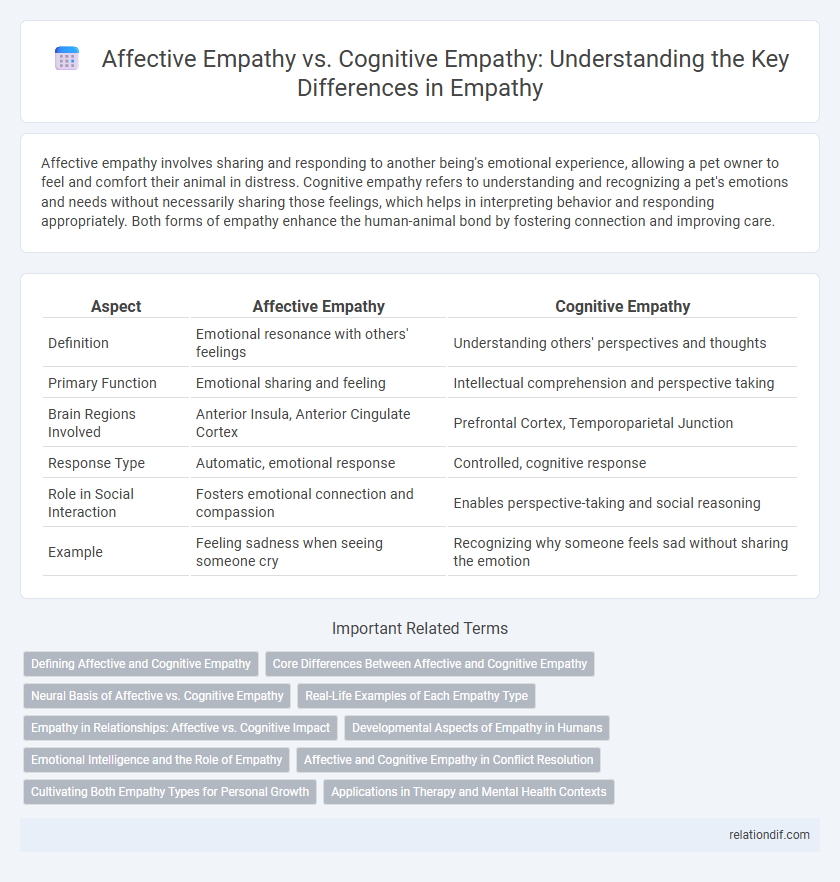Affective empathy involves sharing and responding to another being's emotional experience, allowing a pet owner to feel and comfort their animal in distress. Cognitive empathy refers to understanding and recognizing a pet's emotions and needs without necessarily sharing those feelings, which helps in interpreting behavior and responding appropriately. Both forms of empathy enhance the human-animal bond by fostering connection and improving care.
Table of Comparison
| Aspect | Affective Empathy | Cognitive Empathy |
|---|---|---|
| Definition | Emotional resonance with others' feelings | Understanding others' perspectives and thoughts |
| Primary Function | Emotional sharing and feeling | Intellectual comprehension and perspective taking |
| Brain Regions Involved | Anterior Insula, Anterior Cingulate Cortex | Prefrontal Cortex, Temporoparietal Junction |
| Response Type | Automatic, emotional response | Controlled, cognitive response |
| Role in Social Interaction | Fosters emotional connection and compassion | Enables perspective-taking and social reasoning |
| Example | Feeling sadness when seeing someone cry | Recognizing why someone feels sad without sharing the emotion |
Defining Affective and Cognitive Empathy
Affective empathy involves the ability to emotionally respond and share another person's feelings, enabling a deep emotional connection and compassion. Cognitive empathy refers to understanding another person's perspective or mental state without necessarily sharing their emotions, facilitating effective communication and problem-solving. Both affective and cognitive empathy are crucial for social interactions, with affective empathy driving emotional resonance and cognitive empathy enhancing rational understanding.
Core Differences Between Affective and Cognitive Empathy
Affective empathy involves the capacity to emotionally resonate with another person's feelings, often resulting in shared emotional experiences, while cognitive empathy refers to the ability to intellectually understand another person's perspective or mental state without necessarily sharing their emotions. Core differences include affective empathy's emphasis on emotional contagion and feeling alongside others, contrasted with cognitive empathy's focus on perspective-taking and mentalizing processes. These distinctions highlight affective empathy's role in emotional connection and cognitive empathy's function in social cognition and understanding.
Neural Basis of Affective vs. Cognitive Empathy
Affective empathy primarily engages the anterior insula and the anterior cingulate cortex, regions involved in emotional processing and pain perception, reflecting the visceral sharing of others' emotions. Cognitive empathy relies on the medial prefrontal cortex and temporoparietal junction, which support perspective-taking and mentalizing functions essential for understanding others' thoughts and intentions. Neuroimaging studies indicate distinct but interacting neural networks for affective and cognitive empathy, highlighting their complementary roles in social cognition.
Real-Life Examples of Each Empathy Type
Affective empathy is exemplified when a person instinctively feels another's sorrow, such as crying upon witnessing a friend's grief, demonstrating an emotional resonance. Cognitive empathy, on the other hand, involves understanding another's perspective, like a therapist analyzing a client's thoughts to provide tailored support without necessarily sharing the emotions. In real life, teachers often employ cognitive empathy to navigate diverse student needs, whereas caregivers might rely on affective empathy to emotionally connect and comfort those they care for.
Empathy in Relationships: Affective vs. Cognitive Impact
Affective empathy involves sharing and responding to another's emotional experiences, enhancing emotional intimacy and trust in relationships. Cognitive empathy enables understanding another's perspective without necessarily sharing feelings, facilitating effective communication and conflict resolution. Both forms of empathy contribute uniquely to relationship dynamics, with affective empathy strengthening emotional bonds and cognitive empathy supporting rational problem-solving.
Developmental Aspects of Empathy in Humans
Affective empathy, rooted in emotional resonance, typically emerges early in development as infants respond to caregivers' emotions through mimicry and distress signals, indicating an innate capacity for shared feelings. Cognitive empathy, which involves understanding another's perspective or mental state, develops later in childhood alongside advanced theory of mind skills and executive functions, facilitating more nuanced social interactions. The interplay of neurodevelopmental milestones and social experiences shapes the maturation of both forms of empathy, highlighting critical periods for fostering empathetic abilities in human growth.
Emotional Intelligence and the Role of Empathy
Affective empathy involves the capacity to physically feel and share another person's emotional experience, which enhances emotional intelligence by fostering genuine emotional connections. Cognitive empathy, by contrast, refers to the ability to intellectually understand and predict another's emotions and thoughts, playing a critical role in effective communication and social interactions. Both types of empathy are essential components of emotional intelligence, enabling individuals to navigate complex social environments and respond appropriately to others' emotional states.
Affective and Cognitive Empathy in Conflict Resolution
Affective empathy involves sharing and responding to others' emotions, enabling individuals to genuinely understand pain or joy, which fosters trust and emotional connection during conflict resolution. Cognitive empathy requires recognizing and understanding another person's thoughts and perspectives without necessarily sharing their feelings, facilitating effective communication and problem-solving in disputes. Combining both affective and cognitive empathy promotes comprehensive conflict resolution by addressing emotional and rational aspects of interpersonal disagreements.
Cultivating Both Empathy Types for Personal Growth
Affective empathy involves feeling others' emotions directly, while cognitive empathy focuses on understanding others' perspectives and thoughts. Cultivating both empathy types enhances emotional intelligence, improves social interactions, and fosters deeper personal growth. Developing affective empathy boosts compassion, whereas strengthening cognitive empathy enhances problem-solving and conflict resolution skills.
Applications in Therapy and Mental Health Contexts
Affective empathy involves sharing and responding to another person's emotional experience, which is essential in therapeutic settings for building rapport and trust between therapist and client. Cognitive empathy, the ability to understand another's perspective without necessarily sharing their feelings, is critical for therapists to accurately assess emotions and tailor interventions effectively. Both forms of empathy enhance mental health treatment outcomes by fostering deeper connection and promoting emotional regulation strategies.
Affective empathy vs cognitive empathy Infographic

 relationdif.com
relationdif.com